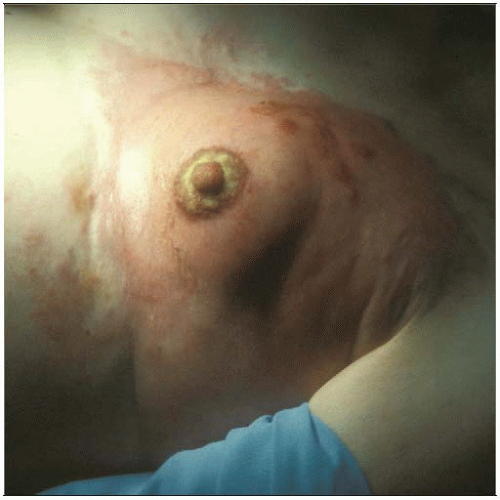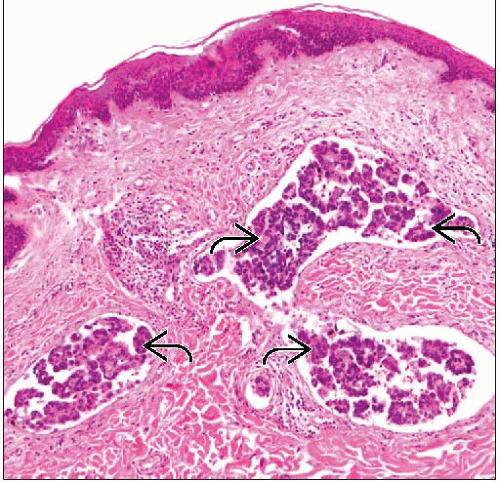Inflammatory Carcinoma
Key Facts
Terminology
Inflammatory breast carcinoma (IBC)
Characteristic clinical presentation of edema and erythema of > 1/3 of breast skin
Clinical Issues
1-5% of all breast cancer cases
May be initially misdiagnosed as mastitis or cellulitis and treated with antibiotics
IBC associated with high risk of locoregional and distant recurrence
Neoadjuvant chemotherapy is standard of care for IBC, followed by mastectomy and radiation
Poor prognosis: Median overall survival is 2.9-4.2 years (5-year survival 30%)
Classified as T4d in AJCC cancer staging
Microscopic Pathology
Prominent dermal lymph-vascular invasion that obstructs lymphatic outflow causing clinical symptoms
True inflammation is not present or is only incidental to carcinoma
Diffusely infiltrative pattern without formation of discrete mass by palpation or imaging
IBC is more likely to be negative for ER and PR and overexpress HER2 than non-IBC
Top Differential Diagnoses
Infection (mastitis, cellulitis, abscess)
Locally advanced carcinoma with skin invasion
Occult IBC
Leukemia and lymphoma
 Inflammatory breast carcinoma is a type of cancer characterized by erythema, edema (peau d’orange), induration, warmth, and tenderness of mammary skin, which can closely mimic an infectious process. |
TERMINOLOGY
Abbreviations
Inflammatory breast carcinoma (IBC)
Definitions
IBC is defined by clinical presentation of disease
Diffuse erythema and edema involving 1/3 or more of breast skin
Gives rise to “peau d’orange” appearance (skin of orange/orange peel)
Clinical appearance results from tumor emboli within dermal lymphatic spaces
Term “inflammatory” refers to clinical appearance of skin, which mimics inflammation
Significant inflammatory infiltrate is not a feature of this type of carcinoma
ETIOLOGY/PATHOGENESIS
Biology of IBC
Gene expression profiling has demonstrated marked transcriptional heterogeneity among IBC samples
Studies have been limited by
Small numbers of cancers due to rarity of the disease
Differing definitions of IBC
Diffuse pattern of infiltration leading to large stroma/tumor cell ratio in samples
IBC includes basal (20-40%), HER2 (20-40%), and luminal A and B subtypes
Suggests that independent gene sets are responsible for molecular subtype and specific characteristics of IBC
1 group has reported nuclear factor-κB (NF-κB) hyperactivation and augmented insulin-like growth factor signaling
Associated with increased tumor cell invasion, angiogenesis, and metastatic potential
It is unclear if this expression pattern is related to absence of ER expression or specifically to IBC
Specific genes responsible for clinical behavior of IBC have not yet been identified but are under active investigation
CLINICAL ISSUES
Epidemiology
Incidence
1-5% of all breast cancer cases
Time-trended data from SEER database suggest incidence may be increasing
Ethnicity
Slightly more common in African-American women
Presentation
Patients usually present with symptoms of warmth, swelling, induration, and erythema of mammary skin
May be initially diagnosed as mastitis or cellulitis and treated with antibiotics
Breast infections rare outside lactational period, and carcinoma should be suspected
Palpable mass may not be present, making diagnosis more difficult
Up to 30% of patients will not have palpable mass; when present, mass is often ill defined
Some patients will have palpable axillary nodes; however, this finding is also common in true inflammatory conditions
Involved breast may enlarge rapidly over a period of weeks
Up to 15% may present with bilateral involvement
This is likely due to cancer metastasizing to contralateral breast
Non-IBC can recur as IBC (“secondary IBC”)
Treatment
Options, risks, complications
Neoadjuvant chemotherapy is standard of care
Goal is to eliminate micrometastatic disease and reduce tumor burden, making tumor more amenable to surgery and radiation
Response to neoadjuvant chemotherapy provides information on prognosis
Pathologic complete response predicts for better outcome
However, 1/2 of patients with pathologic complete response will subsequently recur
Surgical approaches
Stay updated, free articles. Join our Telegram channel

Full access? Get Clinical Tree




